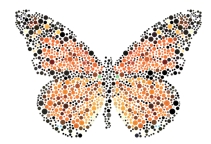
The Story of Ginny’s Gift
This story begins with Ginny’s gift in life which, to everyone she met, was her unlimited capacity for love and compassion that radiated from her body like an aura whose gentle glow first encircled and then embraced all of those whose lives she touched. Whether with her human or animal families, Ginny’s light was contagious, and she taught so many people the true meaning of unconditional love – that you accept those you love for who they are and what they are, dimples and warts alike. She was an inspiration to countless lives, and to the very special few of her innermost circle, she provided the energy and optimism to face each day with hope and determination. Ginny had the innate ability to make those she loved feel good about themselves, and she understood that people who are so empowered experience an inner sense of calm and peace, knowing that no matter what they do or what may happen in life, her love was something on which they could always count and would never waver.
Ginny was born on November 30, 1953 and in her teens she was diagnosed with juvenile-onset epilepsy. For the rest of her life, including all throughout the 32 years of marriage to her beloved husband Don, she dealt with what is called uncontrolled epilepsy. Even though she was strictly compliant with her medication, she was never seizure free. Over the course of her 60 years, she may have had as many as two dozen or more tonic-clonic seizures – a full body seizure that affects the entire brain. Neither Ginny nor Don ever kept a count of the total number because neither believed that it was important. All they knew with certainty is they had to deal with a seizure when one occurred, but both assumed that Ginny would always fully recover after each episode.
On May 6, 2014, Ginny died from what is called SUDEP – Sudden Unexpected Death in Epilepsy. When he was given this cause of death, Don was at a total loss of speech or comprehension. He had to ask the medical examiner to spell it. Neither he nor Ginny had ever even heard of SUDEP, let alone what it was or meant. They didn’t think you could actually die from epilepsy. Not a single one of Ginny’s neurologists over the years had ever mentioned SUDEP. Nor that because Ginny had juvenile-onset and 40 or more ensuing years of uncontrolled epilepsy that she was in the 90% risk pool for death due to SUDEP. It turns out that tonic-clonic seizures cause cumulative and progressive damage to the brain over time. And it turns out that no one except Ginny’s own brain knew that when, some months before, when Ginny had her last seizure, that it truly was her last seizure. There was never going to be another one. On May 6, as she began to seize, her brain said, “no more” and Ginny experienced one of the syndromes of SUDEP known as cerebral shutdown. Within seconds, her brain literally turned her body off, and she was gone. Once it begins, SUDEP is fatal in 100% of cases.
In the months following Ginny’s death, Don buried himself into learning everything he could about SUDEP. He quickly discovered that compared to other diseases, there is practically no scholarly research on SUDEP. And that on the small handful of websites that even talk about SUDEP at all, he saw most of these sites stated that doctors are reluctant to discuss it with patients because it may frighten them. In the course of this exploration, some months later, Don stumbled entirely by accident across a 2013 study that for the first time conclusively linked epilepsy with autism. Especially in adult patients with temporal lobe epilepsy (TLE) the severity of autistic traits was increased with seizure activity. Ginny had TLE. So, just as with SUDEP, there is effectively no research on this connection, and neither Ginny nor Don ever knew it was possible that she could be autistic. However, looking back at a lifetime of living with Ginny, her habits and repetitive behaviors, especially in her last years, Don concluded it’s likely Ginny may have had this type of epileptic autism. There simply was never a dot to connect before, but in retrospect it all became just so apparent to him.
This story ends with Ginny’s gift after death. Rather than be angry and bitter for the rest of his life about never having been told about SUDEP, Don had already decided he was going to form a foundation in Ginny’s name and in her memory which would be dedicated to helping educate people with uncontrolled epilepsy about SUDEP. When he later learned about the connection with autism, Don immediately decided to expand the foundation’s reach to assisting autism centers that treat children with autism alone or combined with epilepsy, and to educate families about the connection between the two. Finally, Ginny had been very proud of her husband’s work in making Wisconsin an early leader in the adoption of MIT-chartered FAB Labs. And, so, with grant funding devoted to these three areas of applied education, Ginny’s foundation was born.
That’s the end of this story, but the rest of story goes on in Ginny’s memory and with the countless thousands of children and families she will help in the decades ahead. The story of ginnysgift.org will now be told over and over again.